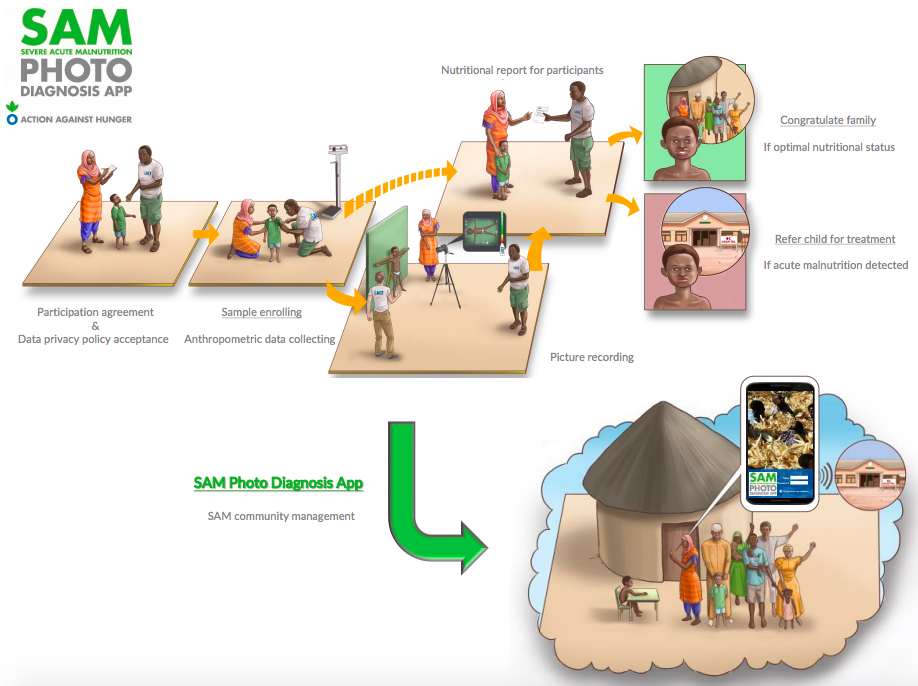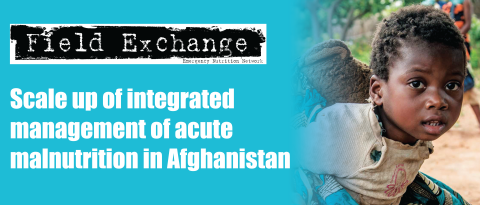Development of a SAM photo diagnosis app
Summary of presentation1
By Laura Medialdea Marcos, Iván Molina Allende and Antonio Vargas Brizuela
Laura Medialdea Marcos is Principal Researcher for the SAM Photo Diagnosis project for Action Against Hunger Spain. She is a PhD candidate in the application of geometric morphometric techniques to physical anthropology.
Iván Molina Allende is the project manager for the SAM Photo Diagnosis project for Action Against Hunger Spain. He has experience in research and evaluations for development cooperation projects.
Antonio Vargas Brizuela is Head Senior Nutrition Advisor at Action Against Hunger Spain. Antonio is a medical doctor specialising in public health and tropical medicine with over 17 years of experience as a general practitioner and health adviser, many of them in development projects in Latin America and Africa.
Cayetana Bazaco, Alejandra Cubillo and Roberto Pedrero are assistant researchers for the SAM Photo Diagnosis App project in the Technical Department, Action Against Hunger Foundation, Spain, and also co-authors of this article.
The authors would like to acknowledge all of the children and families who participated in this study, as well as Action Against Hunger colleagues, field teams and everyone in Dakar, Matam and Louga offices. The authors also acknowledge their academic partners: EPINUT and HUMLOG from Universidad Complutense, Madrid, Spain and Université Cheik Anta Diop, Dakar, Senegal; Ministry of Health in Senegal and regional health authorities and staff in Matam region. Finally, the authors acknowledge the support of their donor, Children’s Investment Fund Foundation.
Location: Senegal
What we know: There are limitations to anthropometric identification of severe acute malnutrition (SAM) in children.
What this article adds: Geometric morphometric (GM) techniques have been used to develop an Android mobile app prototype to diagnose SAM, based on photos of body parts. The method was validated based on 150 healthy Spanish children. A sample of 150 normal weight and 150 Senegalese children with SAM (weight-for-height and MUAC-for-age <-3 z score) was used to quantify morphological differences. The project found significant morphometric differences between Spanish individuals according to their age and sex (p <0.0001); two ‘shapes’ have been identified coinciding with growth peak. Diagnosis of SAM was 93 per cent based on whole body and 100 per cent based on body parts. Further modifications to the app have been undertaken to improve functionality. Further work includes increasing sample sizes to test the approach, technological advances to improve automated diagnostics and user friendliness, and ultimately integration within routine heath systems (as ehealth tools).
Background
The SAM photo diagnosis app is an innovation that responds to the need to improve screening, diagnosis and treatment of severe acute malnutrition (SAM). Anthropometric indicators currently used to diagnose SAM have limitations at population level. Weight-for-height z-score (WHZ) calculation requires well trained health staff and accurately calibrated equipment in good condition. Mid upper arm circumference (MUAC) is easier to use by non-health professionals and requires simpler and cheaper equipment; however intra-observor error is an issue. Therefore, measurement errors are quite likely to take place in SAM screening and diagnosis (Corsi et al, 2017; Marrodán et al, 2013; WHO, 2006). In the last decade there has been a huge technical advance in the field of geometric morphometric (GM) techniques (Slice, 2005; Zelditch, 2004), which has opened up more research into the study of the morphometric variations among biological forms. GM techniques consist of a collection of tools capable of registering the shape of objects for visualisation and quantification of the differences between them. This approach offers a new, innovative opportunity to assess SAM in children.
The potential
The study of the variation in body shape of children under five years of age had not previously been explored with GM techniques. This area is of interest not only for the diagnosis of SAM but also (among other uses) for the study of child growth and its relationship to a wide range of factors, such as environmental, genetic and sociocultural influences. In addition, work is ongoing to involve the community as active agents in the prevention and diagnosis of SAM. The usability and adaptability of tools to support this, suited to local sociocultural realities and sensitive to local contexts and sustainability issues, are highly relevant.
The innovation
The project hypothesised that GM techniques are able to identify shape differences between children of normal weight (NOR) and those with SAM (aged 6-59 months). The main objective of the project was to design a prototype for an Android mobile application (app) which, based on GM techniques, could be validated as an effective and reliable technique for in situ diagnosis of SAM by photographing parts of the body. The development of this tool could help to increase the diagnostic coverage of SAM and thereby strengthen community-based management of acute malnutrition (CMAM) programming at all levels (from health facility to community level) and for a variety of users, such as national health workers, humanitarian workers and academics.
Methods
A sample of 150 healthy NOR children (percentile (p)30-p70 WHZ and/or MUAC for age) between 6 and 59 months of age of Spanish origin was used to validate the methodology designed to record and assess the morphological changes of the body by age and sex. Subsequently, a sample of children between 6 and 59 months of age of Senegalese origin was sub-divided into 150 healthy NOR children and 150 SAM children without complications and used to quantify the morphometric differences of this population according to their nutritional status. SAM cases fulfilled both WHZ and MUAC criteria (WHZ and z-score MUAC for age <-3): children with both deficits were chosen to visualise and quantify morphometric differences among extreme morphologies. Information about the present study was provided to participating children’s families, who signed an agreement form for both participation and acceptance of privacy policies concerning data management. Photographs in anterior view were recorded for each participant in controlled conditions, photographing the same predetermined body regions (extremities and trunk) in the same position for each child, with the child wearing underwear. Although not possible in the prototype, the final app will automatically extract body contour and destroy the real images after the diagnosis is made, as the contour alone is enough to assess nutritional status. This will provide an important level of child protection. The next step was to develop a classifier to allow an effective diagnosis. Finally, a prototype of an Android app was designed.
 Results
Results
Our results show significant morphometric differences between Spanish individuals according to their age and sex (p <0.0001). Two highly differentiated shapes corresponding to the children under and over 24 months were visualised, coinciding with the particular growth peak of the child. When diagnosing SAM, an accuracy of SAM diagnosis above 93 per cent in the Senegalese population was obtained when studying the whole body, increasing to 100 per cent when analysing parts of the body separately. An app prototype which replicates the experiment carried out has already been developed. This prototype permits the systematic registration of photographs as well as image processing and application of a diagnostic algorithm. A methodology to code individuals has also been included. Such a methodology will allow sending and receiving data through the app as well as data storage in a web service. An auxiliary desktop app was also developed to manage and configure the mobile app for the generation of templates and for image processing obtained from digital photographs (made through regular camera shots by third parties) for future research.
Future steps
Future steps include scientific, technological and human-centred design approaches. Concerning the scientific approach, the work will focus on increasing sample sizes to improve diagnostic accuracy, investigation of morphological variability of SAM among populations, and exploration and study of different malnutrition profiles (including WHZ only, MUAC only and stunting). Technological advances will include deep learning and machine learning methods (an artificial intelligence that allows the device to learn and improve the accuracy of the diagnostic functionality as the sample size grows) to automate image registration, processing and classification (where aspects of diagnosis that currently require manual intervention from the user will be automated, such as identification of landmarks on the child’s body). Finally, once the app is functional, it will be upgraded with a user-centred design, with interactive and didactic functionalities, to enable adaptation to specific contexts and allow integration into routine health systems as an ehealth (digital health) tool.
A video about the SAM photo diagnosis app can be found here.
Endnotes
1Presentation at the ACF Research for Nutrition Conference, Pavillon de L’Eau, 13th November, 2017.
References
Corsi DJ, Perkins JM, Subramanian SV. 2017. Child anthropometry data quality from Demographic and Health Surveys, Multiple Indicator Cluster Surveys, and National Nutrition Surveys in the West Central Africa region: are we comparing apples and oranges? Global Health Action;10(1):1328185.
Marrodán MD, Cabañas MD, Gómez A, González-Montero de Espinosa M, López-Ejeda N, Martínez-Álvarez JR, et al. 2013. Technical errors of measurement in the diagnosis of child malnutrition: data from ACF interventions between 2001 and 2010. Nutr Clin Diet Hosp.;33(2):7–15.
Slice DE. 2005. Modern Morphometrics in Physical Anthropology. Developments in Primatology. New York: Kluwer Academic/Plenum Publishers.
Suny Stony Brook. http://life.bio.sunysb.edu/morph/
WHO. Multicentre Growth Reference Study Group. 2006. Reliability of anthropometric measurements in the WHO Multicentre Growth Reference Study. Acta Paediatrica 2006; Suppl 450: 38-46.
Zelditch M. 2004. Geometric Morphometrics for Biologists: A primer. Amsterdam ; Boston: Elsevier Academic Press.


